Vision 2025 - National Research Centre for Grapes
Vision 2025 - National Research Centre for Grapes
Vision 2025 - National Research Centre for Grapes
You also want an ePaper? Increase the reach of your titles
YUMPU automatically turns print PDFs into web optimized ePapers that Google loves.
Salt Creek are under evaluation. Techniques <strong>for</strong> improving water use efficiency through irrigation<br />
scheduling based on pan evaporation and vine growth stage, subsurface irrigation and use of mulch<br />
were developed. Petiole nutrient guide <strong>for</strong> Thompson Seedless grown on Dogridge rootstock was<br />
developed. Technique <strong>for</strong> improving the fertilizer use efficiency through growth stage wise<br />
fertigation scheduling was developed. The causes of few disorders were identified as nutrient<br />
imbalances, which could be corrected by proper nutrient application.<br />
The schedule <strong>for</strong> economic use of bio-regulators in enhancing bud-break and <strong>for</strong> improving bunch<br />
and berry quality was standardized. The canopy architecture, canopy size and the bunch number and<br />
size <strong>for</strong> optimizing fruit quality in Tas-A-Ganesh variety grafted on Dogridge rootstock was<br />
standardized. Nursery techniques <strong>for</strong> increasing rooting and further establishment of different grape<br />
rootstocks were also standardized.<br />
Disease <strong>for</strong>ecasting based on continuous automatic weather monitoring and use of software<br />
'Metwin 2' from Austria was found useful in fungicide spray scheduling <strong>for</strong> effective and economical<br />
management of downy mildew and anthracnose diseases. For the management of the important<br />
disease, powdery mildew, an expert system was developed, released and being used by the growers.<br />
Safe fungicides and practices to improve fungicide use efficiency were identified. Seasonal incidence<br />
of major insect pests was studied. New generation pesticides, environmentally friendly chemicals,<br />
botanicals were tested <strong>for</strong> bio-efficacy and residue data in controlling diseases and insect pests and<br />
effective molecules were included in the recommended schedule <strong>for</strong> their management. Dissipation<br />
rate kinetics <strong>for</strong> many chemicals were studied and their PHI were calculated to recommend their safe<br />
use.<br />
The post harvest pathogens in Indian grapes were identified and Botrytis cinerea, which is the<br />
worldwide major post harvest pathogen, was not found to be a problem in Indian grapes. Pre-harvest,<br />
harvest and post-harvest practices to minimize post-harvest losses, including use of Trichoderma<br />
harzianum, <strong>for</strong> biocontrol of diseases, were identified.<br />
TRANSFER OF TECHNOLOGY BY THE INSTITUTE<br />
The <strong>Centre</strong> has <strong>for</strong>med a very strong communication network through seminars arranged by the<br />
grape growers' associations in major grape growing states, popular agricultural magazines and<br />
newspapers, extension literature, training programmes, and agricultural fairs etc. <strong>for</strong> reaching out to<br />
growers and advising them on new technologies, various improved viticultural practices, and on<br />
specific problems arising due to climate, weather or problems in vineyard management. A lot of this<br />
in<strong>for</strong>mation is also displayed on the Institute's website.<br />
IMPACT ASSESSMENT AND OPTIONS FOR THE FUTURE<br />
The technologies generated by the <strong>Centre</strong> have been well accepted by the growers and are now in<br />
practice. This has helped in improving input use efficiency of various agrochemicals; sustaining<br />
production under adverse conditions of soil, water and environment; improving fruit quality and<br />
minimizing post-harvest losses, especially in the export sector. Hence, the <strong>Centre</strong> has established<br />
very good credibility among the client group. However, there are many issues and problems in Indian<br />
viticulture, which are to be resolved in years to come through applied, basic and strategic research.<br />
Increasing quality production of table grapes at competitive price is the major issue facing the<br />
industry. Abiotic and biotic stresses like continuous drought, soil and water salinity and the high<br />
incidence of diseases and pests; chances of pesticide residues at harvest; besides high yields; are the<br />
major factors that have affected the quality of fruits. Moreover, nutrient imbalances, improper<br />
canopy management leading to low food reserves in the vines, temperature extremes as well as the





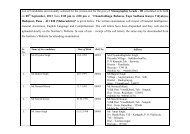
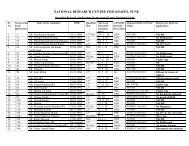

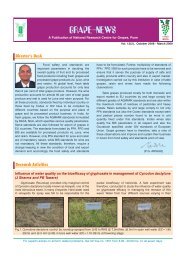

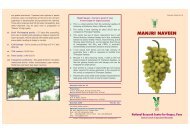
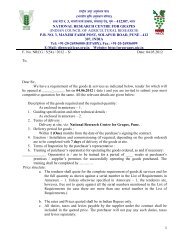



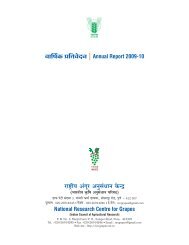
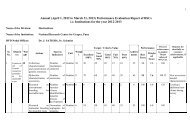
![mj]mJ{V cmcH$m{irM{ (_mBQâ¤>g) oZ`ÃÃU](https://img.yumpu.com/33367555/1/190x127/mjmjv-cmchmirm-mbqag-ozaau.jpg?quality=85)